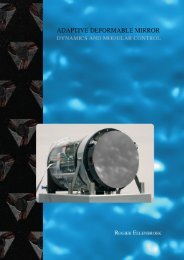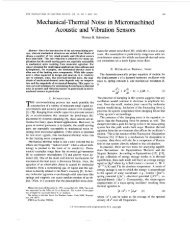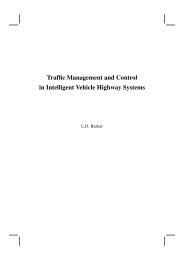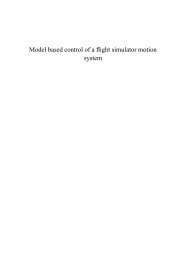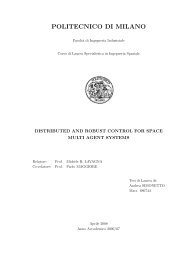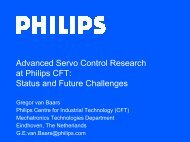Download GRID Feedback 2002 No.2 - Delft Center for Systems and ...
Download GRID Feedback 2002 No.2 - Delft Center for Systems and ...
Download GRID Feedback 2002 No.2 - Delft Center for Systems and ...
You also want an ePaper? Increase the reach of your titles
YUMPU automatically turns print PDFs into web optimized ePapers that Google loves.
A possible future direction is to focus on the development of design-support tools that<br />
will automatically generate alternative solutions (models, controllers) to the problem<br />
at h<strong>and</strong>. By means of an autonomous commissioning system, several of these<br />
solutions could then be deployed simultaneously in some kind of self-organizing<br />
controller (by using evolutionary programming, <strong>for</strong> instance). A step further would be<br />
the integration of this concept with the design of the process itself.<br />
Sensors <strong>and</strong> cognition<br />
Biological organisms are equipped with a highly efficient, redundant system <strong>for</strong><br />
sensing the environment, processing <strong>and</strong> storing the acquired in<strong>for</strong>mation. This is<br />
something we still can only dream of in the case of man-made systems. Clearly, a<br />
major progress can only be achieved with the use of new, much more af<strong>for</strong>dable<br />
sensor technologies. However, along with better sensors, we need to develop tools<br />
<strong>for</strong> interpreting the acquired data <strong>and</strong> storing them in the <strong>for</strong>m of knowledge.<br />
Step by step?<br />
AI techniques, such as neural networks, fuzzy logic, genetic algorithms, etc., have<br />
undoubtedly contributed to the progress of automatic control by gradually extending<br />
the functionality of more traditional control systems. However, the intriguing question<br />
is whether these small incremental improvements in control will eventually lead to the<br />
synthesis of truly intelligent systems. Some believe they will, others argue that this is<br />
like trying to build an airplane by successively improving the car engine. It is difficult<br />
to predict the future developments, but, at this moment, it seems quite certain that <strong>for</strong><br />
the next several decades, intelligent control will remain one of the most challenging<br />
fields of engineering <strong>and</strong> science.<br />
Contact: r.babuska@its.tudeft.nl, http://Lcewww.et.tudelft.nl/~babuska<br />
Further reading<br />
Harris, C.J., C.G. Moore <strong>and</strong> M. Brown (1993). Intelligent Control, Aspects of Fuzzy<br />
Logic <strong>and</strong> Neural Nets. World Scientific, Singapore.<br />
Haykin, S. (1994). Neural Networks. Macmillan Maxwell International, New York.<br />
Jang, J.-S.R., C.-T. Sun <strong>and</strong> E. Mizutani (1997). Neuro-Fuzzy <strong>and</strong> Soft Computing; a<br />
Computational Approach to Learning <strong>and</strong> Machine Intelligence. Prentice-Hall,<br />
Upper Saddle River.<br />
Klir, G.J. <strong>and</strong> B. Yuan (1995). Fuzzy sets <strong>and</strong> fuzzy logic; theory <strong>and</strong> applications.<br />
Prentice Hall, Upper Saddle River.<br />
Passino, K. M. <strong>and</strong> S. Yurkovich (1998). Fuzzy Control. Addison-Wesley,<br />
Massachusetts.<br />
Zurada, Jacek M., Robert J. Marks II <strong>and</strong> Charles J. Robinson (Eds.) (1994).<br />
Computational Intelligence: Imitating Life. IEEE Press, Piscataway, NJ.<br />
12




